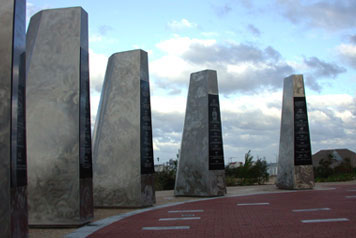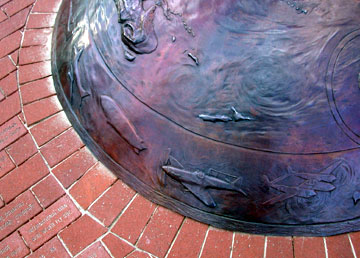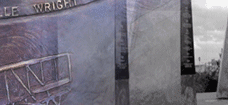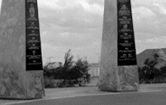Historic Events, a
sampling
Appreciation is expressed to Dr. Tom Crouch, senior curator of the Division of Aeronautics
at the Smithsonian Air and Space Museum, and to Steve Alterman, President of
the Cargo Airline Association, for their encouragement in the compilation of
significant aviation accomplishments incorporated on the Monument's granite
panels. And to artist Glenn Eure who created the images which embellish the
language.
December 17 · 1903
Kitty Hawk, NC
Orville and Wilbur
Wright accomplish world's first powered, controlled, sustained manned flight in
heavier-than-air machine
May 20-21 · 1927
Charles Lindbergh in
his Spirit of St. Louis becomes first to solo across the
Atlantic
1931
Britain's Frank
Whittle designs jet engine
May 20-21 · 1932
Amelia Earhart
becomes first woman and second person to fly solo across the
Atlantic
1957
Soviets launch first
artificial satellite in space, Sputnik 
July 20 · 1969
Neil A. Armstrong
walks on the moon
ONE SMALL STEP FOR MAN;
ONE GIANT LEAP FOR
MANKIND
1976
Viking
Landers touch down on Mars
Humankind is a
continuum of pioneers sharing timeless dreams and the boundless possibilities
of vast unexplored worlds.
|

The
Artists
The concept for the Kitty Hawk Monument to a Century of Flight, with its orbit of ascending wing-shaped pylons
depicting man's journey in a single century from earthbound to the moon and
beyond, is that of Outer Banks of North Carolina artist, Glenn Eure. The design
evolved out of the collaborative efforts of Eure and two acclaimed sculptors,
Hanna Jubran and Jodi Hollnagel Jubran. The Jubrans are professors at East
Carolina University School of Art and are involved in the creation of public
sculptures around the world. They fabricated the Monument's pylons and created
the center bronze dome.

Left to right:
Hanna Jubran, Jodi Hollnagel Jubran, Glenn Eure
Design
Features
 The Monument's essential structure consists of
fourteen wing-shaped stainless steel
pylons (shown top) ascending in height from 10 feet to 20 feet in an
orbit of 120 feet, the distance traveled by the brothers Orville and Wilbur
Wright in that historic "first" flight on December 17, 1903.
The Monument's essential structure consists of
fourteen wing-shaped stainless steel
pylons (shown top) ascending in height from 10 feet to 20 feet in an
orbit of 120 feet, the distance traveled by the brothers Orville and Wilbur
Wright in that historic "first" flight on December 17, 1903. Each pylon's curved side correlates with a
wing foil. Each pylon's curved side correlates with a
wing foil.
 The flat faces of the pylons showcase
black granite panels engraved with
language and images about one hundred of the most significant events in
aviation in its first century (shown left). The flat faces of the pylons showcase
black granite panels engraved with
language and images about one hundred of the most significant events in
aviation in its first century (shown left).
 The orbit of pylons culminates in a center
bronze dome, (shown below) six feet
in diameter, depicting the continents of earth joined by a centennial message
coming from Kitty Hawk. The orbit of pylons culminates in a center
bronze dome, (shown below) six feet
in diameter, depicting the continents of earth joined by a centennial message
coming from Kitty Hawk.

 Inside the orbit of pylons and surrounding the center
bronze, the heartbeat of the Monument is a
courtyard of 4,600 bricks
engraved with messages of sponsors from around the world. Inside the orbit of pylons and surrounding the center
bronze, the heartbeat of the Monument is a
courtyard of 4,600 bricks
engraved with messages of sponsors from around the world.
 At the Monument's entrance is
a granite marker
inscribed with the poem “High Flight,”words from the past
written by James G. Magee, Jr., a 19-year-old American pilot, that echo
eloquently over the decades for all aviators who have danced the skies on
laughter-silvered wings and joined the tumbling mirth of sun-split clouds.
(Click here to read "High Flight.) At the Monument's entrance is
a granite marker
inscribed with the poem “High Flight,”words from the past
written by James G. Magee, Jr., a 19-year-old American pilot, that echo
eloquently over the decades for all aviators who have danced the skies on
laughter-silvered wings and joined the tumbling mirth of sun-split clouds.
(Click here to read "High Flight.)
 A
time capsule placed by the First Flight Club of Rotary International
beside the granite entrance marker to the Monument is carrying messages to the
people of 2103. A
time capsule placed by the First Flight Club of Rotary International
beside the granite entrance marker to the Monument is carrying messages to the
people of 2103.
 The Monument to a Century of Flight is a
public park open and accessible to all without admission charge. The Monument to a Century of Flight is a
public park open and accessible to all without admission charge.
|


